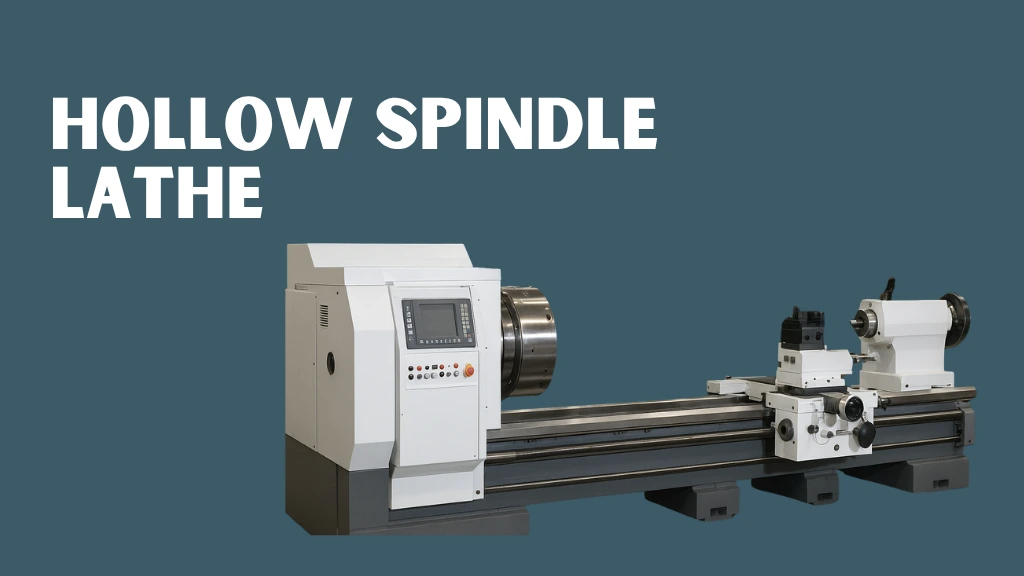In the world of precision machining, the hollow spindle lathe is a vital tool for industries that handle long and heavy workpieces. Its unique design allows large-diameter materials to pass through the spindle, facilitating machining of extended components without the need for repositioning. This capability makes it indispensable in sectors such as oil and gas, aerospace, automotive, and heavy manufacturing.
Understanding the design, features, and benefits of these machines helps manufacturers make informed decisions, ensuring operations remain efficient, safe, and precise. For organizations relying on heavy-duty machining, investing in this equipment can significantly improve productivity. It also reduces errors over time, contributing to cost savings and better-quality output.
What Is a Hollow Spindle Lathe
A hollow spindle lathe is a specialized machine designed with a hollow spindle, which allows long workpieces to pass through the center. This enables continuous machining of extended materials like pipes, shafts, and rods, minimizing the need for repositioning. The hollow spindle is particularly advantageous for industries that require precision over long distances, as it maintains alignment and reduces errors caused by multiple setups.
These machines are available in both manual and CNC configurations. Manual models are ideal for smaller workshops or specialized tasks, while CNC-enabled versions are suited for large-scale operations requiring high repeatability and automation. The combination of precise spindle alignment, high-quality motors, and durable construction ensures consistent performance across a wide range of machining tasks.
Key Features of the Machine
The most notable feature of a hollow spindle lathe is its hollow spindle, which allows long materials to be inserted directly into the machine. This design ensures that rods, shafts, or drill pipes can be machined continuously without stopping for repositioning, greatly improving efficiency in industrial operations. By accommodating extended workpieces, the machine minimizes setup time and helps maintain alignment for precise machining.
In addition to the hollow spindle, many of these lathes are designed with a large swing capacity. Swing capacity refers to the maximum diameter that can rotate around the axis of the lathe, allowing the machine to handle a wider variety of workpieces. This feature makes the lathe versatile enough for applications in industries such as aerospace, automotive, metal fabrication, and shipbuilding, where different component sizes and diameters are common.
Construction quality is another defining factor. These machines are built with reinforced beds, precision-ground spindles, and powerful motors to ensure stability during machining and reduce vibration. Some models operate manually, giving skilled operators full control over the process, while others feature CNC systems for automated operations. CNC-enabled machines allow complex tasks to be executed with minimal human intervention, improving repeatability and reducing errors.
Industrial Applications
Hollow spindle lathes are essential in industries where large or long workpieces require precise machining. In the oil and gas sector, these machines are used to manufacture drill pipes, casings, and other large components necessary for exploration and production. The ability to handle extended materials in a single setup saves considerable time and reduces labor costs. This efficiency makes them a valuable asset in demanding industrial environments.
In aerospace and automotive manufacturing, these lathes are employed to produce precision engine components, shafts, and turbine parts. These industries demand tight tolerances and exact specifications, which the equipment can consistently deliver. Metal fabrication shops also rely on them to turn and finish long rods, shafts, and tubing, maintaining high quality and productivity across all projects.
Shipbuilding benefits significantly from this technology as well. Large propeller shafts, rudder stocks, and other critical mechanical components require long, precise machining operations. The hollow spindle design allows these parts to be machined efficiently while ensuring accuracy and reducing the need for multiple setups.
Overall, the applications of these machines extend to any sector that requires extended or heavy cylindrical workpieces. Their versatility, precision, and efficiency make them indispensable in modern industrial machining. Companies across multiple industries rely on these lathes to streamline production and maintain consistent quality.
Real-World Example
A practical case comes from Baker Hughes, a leading provider of oilfield services and equipment. In 2022, one of their refineries needed to machine extremely long pump shafts, each over 20 feet in length. These components required exact tolerances for high-speed rotating equipment, making precision and efficiency essential for continuous operation.
Using a lathe with a 10-inch spindle bore and a 50-inch swing capacity, the refinery completed turning, threading, and finishing operations in a single setup. Eliminating multiple repositioning steps reduced production time by approximately 35% and minimized the risk of misalignment. This streamlined process ensured faster delivery and consistent quality for all shafts.
The precise machining improved the overall efficiency and reliability of the pumps, which are critical for uninterrupted refinery operations. By leveraging advanced equipment, Baker Hughes maintained high productivity while reducing material waste and labor costs. This example demonstrates how a hollow spindle machine can deliver substantial gains in precision and efficiency.
Benefits of Using This Machine
One of the most significant advantages of a lathe hollow spindle is its ability to handle long workpieces with minimal repositioning, which reduces operational downtime and enhances overall efficiency. This feature is particularly valuable in industries like aerospace, automotive, and oil and gas, where precise machining is critical. Reducing setup time not only saves costs but also ensures consistent quality across production runs. Manufacturers with heavy-duty machining operations benefit greatly from this combination of efficiency and reliability.
Precision is another key benefit. By maintaining perfect alignment across long materials, these machines ensure consistent results, even for complex shapes or threading operations. Industry experts, including Summit Machine Tool engineers, emphasize that precision directly impacts the performance and safety of critical components. Maintaining high accuracy minimizes material waste and reduces costly rework, contributing to both financial and operational efficiency.
Versatility and durability further add to the machine’s appeal. These lathes can handle a variety of metals, from steel to aluminum and brass, and accommodate components of different sizes. Built to withstand continuous, heavy-duty operations, they maintain high performance over time, reducing the need for frequent maintenance. Expert machinists recommend investing in high-quality equipment to achieve long-term productivity, safety, and consistent machining excellence.
Maintenance and Safety Practices
Proper maintenance is critical to keep hollow spindle machines operating efficiently. Regular tasks include lubricating moving parts, checking spindle alignment, replacing worn components, and calibrating controls and tooling. Following a scheduled maintenance routine prevents unexpected breakdowns, ensures consistent machining quality, and extends the life of the machine.
Safety is equally important. Operators must adhere to established safety protocols, including wearing appropriate protective gear, receiving adequate training, and handling tools correctly. Organized tool storage and adherence to operational guidelines also help prevent accidents.
Equally important is ensuring proper setup of workpieces and tools. Misalignment or incorrect clamping can lead to poor quality, damage to the machine, or even accidents. Operators should double-check setups before initiating machining processes to maintain both safety and product quality.
Expert Insights from Industry Leaders
Industry professionals emphasize several benefits of using these machines that are often overlooked. Machining long workpieces in a single setup significantly reduces labor hours and increases overall efficiency. Accuracy is improved because there is less chance of misalignment, which also minimizes material waste. These advantages make operations more reliable and cost-effective for manufacturers.
CNC-enabled models allow operators to perform complex operations like threading, tapering, and precision boring with minimal intervention. This advanced functionality improves consistency across multiple parts and enables companies to scale production without adding extra workforce. Companies such as Summit Machine Tool and Lehigh Lathe offer machines that integrate these features, providing reliable performance and expert support. Leveraging their experience helps manufacturers achieve optimal results while maintaining safety and efficiency.
Conclusion
The hollow spindle lathe is a vital tool in modern machining, particularly for industries handling long, heavy, or precision components. Its hollow spindle design, large swing capacity, and robust construction allow manufacturers to achieve high efficiency and consistent accuracy. Optional CNC integration further enhances precision and reduces manual intervention, making operations more reliable and productive.
Proper maintenance, adherence to safety protocols, and skilled operation maximize the machine’s value. Regular inspections, lubrication, and alignment prevent downtime and maintain consistent performance. By following best practices and learning from industry experts, companies can fully leverage the capabilities of this machine, achieving durability, precision, and optimized production processes.
FAQs
What is the main benefit of using this type of lathe?
The main benefit is the ability to machine long workpieces without repositioning, improving efficiency and accuracy.
Can these lathes be operated manually?
Yes. Some models operate manually, while others are CNC-enabled for automated precision machining.
Which industries benefit most?
Industries such as oil and gas, aerospace, automotive, shipbuilding, and heavy metal fabrication benefit the most.
How often should maintenance be performed?
Maintenance should follow the manufacturer’s guidelines, including weekly lubrication, monthly inspections, and periodic calibration.
Are different sizes available?
Yes. Spindle bores range from 4 inches to over 9 inches, and swing capacities vary to suit diverse machining needs.




